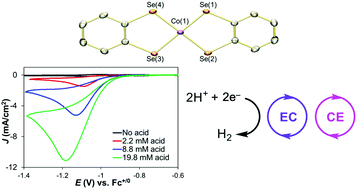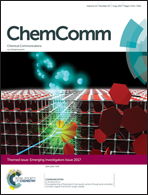H2 evolution by a cobalt selenolate electrocatalyst and related mechanistic studies†
Abstract
[Co(bds)2][nBu4N] (where bds = 1,2-benzenediselenolate) was identified as an electrocatalyst for the hydrogen evolution reaction. Mechanistic studies indicated that a black precipitate, which formed upon treating [Co(bds)2]− with acid, as well as the one-electron reduced species, [Co(bds)2]2−, were viable catalytic intermediates. We propose two kinetically-competent pathways for H2 evolution: EC and CE (E = electrochemical, C = chemical step).

- This article is part of the themed collection: 2017 Emerging Investigators


 Please wait while we load your content...
Please wait while we load your content...